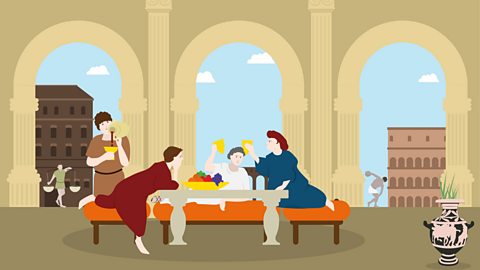Key points
- The Roman Empire began in 27BC when Augustus became the first official Roman emperor.
- At its height, the Roman Empire spanned as far west as northern England and as far east as Syria.
- The emperor was the leader of the Roman Empire and had powers similar to a king.
- The emperor was assisted in passing laws by the SenateA political group of men, responsible for making laws in the Roman Empire. They were appointed by elected officials..
- The Roman army was an important factor in helping them conquer and control their empire.
The origins of the Roman Empire
According to Roman scholar Marcus Terentius Varro, the city of Rome was founded in April 753BC. and was formed from settlements gathered around the River Tiber.
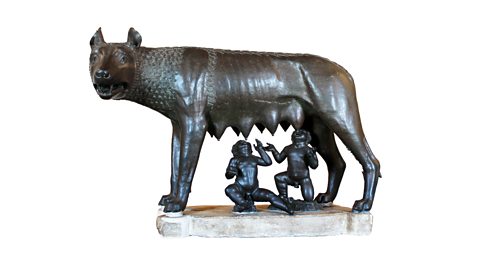
The mythA story about early history, often involving supernatural beings or events. Myths feature heavily in the cultures of Ancient Rome and Ancient Greece. of Romulus and Remus was the Roman explanation for the creation of Rome. Romulus and Remus, two quarrelsome brothers who were raised by a wolf, could not agree on where to build a new city, so they consulted the birds to see which brother had the right idea. According to the myth Romulus won and built the city of Rome, which was named after him.

Early inhabitants and conflict
The early inhabitants of Rome were a mix of people from Latin and Sabine tribes. Over time, they made alliances with other cities which resulted in the creation of what is now known as modern-day Italy.
In the 3rd century BC, Romeās most powerful rival was CarthageA city in modern day Tunisia. In the ancient world, Carthage controlled a large empire that included land in North Africa, southern and western Europe. Their empire collapsed following wars with the Romans..
- Between 264BC and 146BC, the Romans fought three wars with Carthage, known as the Punic Wars.
- This resulted in the Romans winning control of Carthageās overseas territories in North Africa, the Mediterranean and southern Europe.
By 58BC the Romans had an empire that stretched from the deserts of North Africa and Syria to Portugal. These lands outside of the boundaries of Rome became known as provinceAn area of land controlled by the Roman Empire outside of the borders of Rome itself.. The provinces were ruled by Roman law.
Who ruled ancient Rome?
Rome was originally ruled by a king from when it was founded, until 509BC when the king, Tarquinius Superbus, was overthrown. Rome then became a republicA country which is not ruled by a king or queen. and was ruled by several key groups, including:
- Two consulOne of two people elected to govern Rome for a year. who governed the country and were in charge of the army.
- The SenateA political group of men, responsible for making laws in the Roman Empire. They were appointed by elected officials., whose members were appointed by the consuls, raised money to pay for the running of the country and helped to decide foreign policy.
- Different assemblies in the Roman republic including:
- The Comitia Centuriata - This was the assembly of the soldiers, they elected magistrates and passed laws.
- The Comitia Tributa - This assembly was made up of all Roman citizens, and had the power to pass laws and elect magistrates.
- The Concilium Plebis - This was the assembly of the plebeians - the ordinary people. It had the power to pass laws known as plebiscites and it elected tribunes.
- Tribunes represented the rights and views of plebeians in Rome. They had the power to block laws from consuls that they thought were unfair.
Key Roman rulers

Image caption, Take a look at some of the key Roman rulers mentioned in this article.
Image caption, King Tarquinius Superbus
The last Roman king was Tarquinius Superbus. He murdered his father-in-law to become king.
Image caption, Julius Caesar
Caesar was a Roman consul from 46BC to 44BC. He was eventually given the title of ādictator for lifeā in 44BC, meaning he could rule the Roman Empire alone. He was assassinated in the Senate by political opponents who were concerned he was too powerful.
Image caption, Emperor Augustus
Emperor Augustus was the first Roman emperor. He took control of the empire after a power struggle with Mark Antony following the assassination of Julius Caesar. His army conquered Spain and land in North Africa.
Image caption, Emperor Claudius
Emperor Claudiusā army conquered land in Turkey, Judea and Britain. Claudiusā invasion of Britain was commanded by General Aulus Plautius. Their forces quickly gained control over the lands and people in what is now south east England. Claudius was celebrated in Rome for the successful invasion of Britain.
1 of 5
The role of the emperor
Following the end of the Roman republic, in the Roman Empire, power was held by the emperor. He was:
- head of the Senate
- head of the army
- Pontifex Maximus - as the chief high priest he acted as the head of Roman religion
The Senate and the assembly
Other groups in Rome such as the Senate or assembly had largely advisory roles to support the emperor in ruling the empire. The emperor had control of the powerful Roman army and also ruled over provinceAn area of land controlled by the Roman Empire outside of the borders of Rome itself. which had been conquered by the Roman Empire.
During the time of the Roman Empire, the Senate had less power than the emperor, who had the right to make decisions alone. Senators were appointed by the emperor. To be chosen as a senator they needed to have been elected by Roman citizens to an official position such as magistrate. They administered decisions and laws introduced by the emperor, and oversaw law and order in Rome.
Activity - Who would you be in Roman times?
The expansion of the Roman Empire
As the Roman Empire expanded, the emperor needed more money. This was collected through taxes from the provinceAn area of land controlled by the Roman Empire outside of the borders of Rome itself., which made Rome very wealthy.
Take a look at the maps below to see how the Roman Empire changed over time.
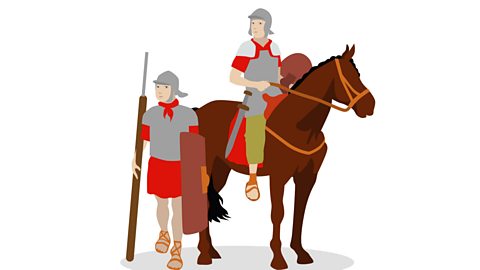
The Roman army
When conquering new lands, the Romans often met fierce opposition. However, the Roman army was highly trained and well-equipped.
- The army was divided into legionA group of approximately 5,000-6,000 soldiers in the Roman army. of between 5,000 and 6,000 men
- Each legion was split into groups of around 80 to 100 men, which were known as cohorts or centuria
This organisation meant everyone knew their role and what was expected of them. The Roman army was very effective.
When they took over new land, the Romans also captured people and enslaved them. For example, during wars with Greece in 167BC, some historians have estimated that the Romans enslaved up to 150,000 people.

Why was the Roman army so successful?
- The Roman army was well-trained and had better equipment than other armies.
- Everyone in the army had a role and knew what they needed to do - they were well organised.
- The Roman army also used highly effective tactics, such as the ātortoiseā formation, where soldiers overlapped their shields to protect themselves as they advanced.
Provinces
To control the empire, the Romans classed their provinceAn area of land controlled by the Roman Empire outside of the borders of Rome itself. in two ways.
| Senatorial | These provinces did not share a border with a country outside the Roman Empire. They were run by a governor, who was usually a senator. They were considered to be at low risk of rebelling or being invaded. Corsica and Sardinia were examples of provinces in this category. Both of these places are islands in the Mediterranean and are close to Rome. |
| Imperial | These provinces were on the border of the Empire and were not considered secure. They were run by army generals to give them greater security. Britain was an example of an imperial province. It is a long way from Rome and faced rebellions, such as Boudicaās revolt. |
Why did imperial provinces have to be run by the army?
Imperial provinces were far away from Rome and so were not as secure as the Senatorial provinces that were closer to Rome.
How did the Romans conquer and control Britain?
55BC - An attempt to invade
The first attempt by the Romans to invade Britain was made by Julius Caesar in 55BC. Caesar believed conquering Britain would show how powerful and successful he was as a leader. He was also frustrated that some Britons were helping people in GaulA Roman province, covering land in largely modern day France, Germany, Belgium and Luxemburg. resist Roman rule.
Caesar sailed to Britain from France and landed in Kent. He took 12,000 men with him, but British warriors were waiting. After a series of small battles, Caesar realised the invasion could not succeed.
Ships transporting his cavalrySoldiers who fought on horseback. had been delayed leaving Gaul, then bad weather stopped them landing in Britain. The same bad weather badly damaged Roman ships that had transported men across the English Channel. The Romans were running out of food. Caesar ordered the ships to be repaired and defeated the British in a battle while the work was done.
54BC - Returning to Britain
Caesar returned to Britain the year after his first invasion. This time with far greater numbers of soldiers Roman historian Cassius Dio said this landing was more successful than the previous year because there was āno one daring to oppose him because of the number of his ships and the fact that they approached many points on the shore at the same time.ā After achieving some success against the British warriors, who began to retreat, Caesar was again hindered by bad weather.
How did bad weather hinder Caesar's invasion?
He wrote that āalmost all the ships were dashed to pieces and cast upon the shore, because neither the anchors and cables could resist, nor could the sailors and pilots sustain the violence of the storm; and thus great damage was received by that collision of the ships.
When he returned to his ships, Caesar found that around 40 of them āhad been lost,ā with lots of others needing to be repaired.
Perhaps the most significant battle of the invasion took place at the River Thames. British tribal leader Cassivellaunus had put sharpened wooden spikes both in the river and on the shore to try and slow down the Romans.
Caesarās cavalry easily passed through the defences and defeated Cassivellaunusā men. Caesar did not want to stay in Britain during the winter, so negotiated a peace settlement with Cassivellaunus.
This opened up trading opportunities between the Roman Empire and Britain to increase the wealth of the empire. Although he hadnāt conquered Britain, this invasion was seen as a success. Caesar had made up for the failure of the previous year and shown his success as a military leader.
AD43 - The conquest of Britain
Nearly 100 years after Caesarās invasions, Emperor Claudius decided to invade Britain. He had similar motives to Caesar. The British were still supporting resistance in Gaul against Roman occupation, and he wanted to show that he was a successful leader.
In AD43 he had been emperor for 2 years, so wanted to show he could control and expand the empire. He sent General Aulus Plautius to lead the invasion. This time the Romans were successful. There were several reasons for this:
- British tribes had been fighting against each other in the years before the invasion, so they were weakened in being able to face the strength of the Roman army.
- The Romans landed in three separate places on the south coast, making them harder to defeat.
- The invading force was well armed. Roman historian writer Cassius Dio wrote that they had āextensive equipment, including elephants.ā
- British tribes were not expecting an invasion, so were not prepared as they had been when Caesar arrived in Britain.
- As some trading links had been established between Britain and Rome, some tribes were willing to seek a peace agreement with Plautius.
Claudius travelled to Britain once it was clear the invasion was going to succeed. He accepted the surrender of several tribal leaders and returned to Rome victorious.
Later, the Romans tried to conquer Scotland but were unsuccessful. The landscape of Scotland meant Scottish warriors could go into hiding and launch attacks on the Romans.
Hadrian's wall
Emperor Hadrian visited Britain in AD122 and ordered that a wall should be built near the modern-day border between Scotland and England, which marked the northern edge of the empire. He said he wanted the wall to āseparate the barbarians from the Romansā.
Hadrianās policy as emperor was to try and preserve the Roman Empire, fearing if it continued to grow it would be too difficult to control. This was a change from previous emperors who had concentrated on trying to conquer new territory to show their success.
AD61 - Boudicaās rebellion
- Boudica was married to the king of the Iceni tribe, Presutagus.
- She lived in what is now Norfolk, East Anglia.
- Presutagus had an agreement with the Romans that his family would inherit his land when he died.
- The Romans broke their agreement when Presutagus died in AD61, attacking Boudica and her two daughters, and seizing their land.
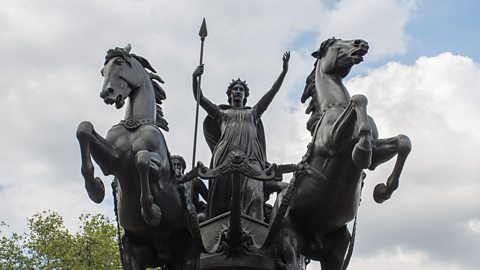
Queen Boudica raised an army against the Romans, and she and her rebel army raided the Roman capital city of Colchester, killing thousands of people and destroying anything that represented Rome. They also burned Londinium (London) and Verulamium (St Albans) to the ground. It is estimated that Boudicaās army killed up to 70,000 Romans.
Boudicaās rebellion meant the Romans had to move soldiers from their efforts fighting against Druids to try and conquer Anglesey. Tacitus, who was a Roman politician and historian, wrote āthe sudden revoltā meant they had to go and deal with Boudica.
Boudica and her army were defeated at the Battle of Watling Street. Roman writer Tacitus said the Roman army was brutal in dealing with Boudicaās supporters. He said āby some accounts, little less than eighty thousand Britons fell, at a cost of some four hundred Romans killed and a not much greater number of wounded.ā
Historians can't be certain how Boudica died. Tacitus wrote that she took poison to end her life after realising that her army was defeated.
Economy and trade
The economy of Rome prospered during the Empire because resources could be taken from the provinceAn area of land controlled by the Roman Empire outside of the borders of Rome itself. to Rome. For example, in Britain there were silver, lead and copper mines. The provinces also had to pay taxes which increased Romeās wealth.
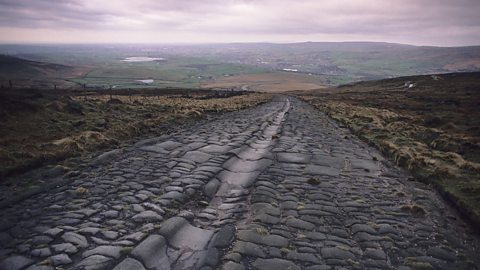
There were many reasons the economy did well:
- The Romans mined precious metals, using techniques that were not improved upon until the 1800s.
- Wealthy Romans owned huge agricultural estates called latifundia which were worked on by enslaved people. Their farming methods, such as irrigation, water mills, manure and mechanical reapers, were technologically advanced compared to previous civilisations.
- They built straight, paved roads such as Watling Street in Britain. It ran from London to Wroxeter in Shropshire.
How far was a Roman mile?
The word mile comes from the Latin word for āthousandā. The Romans measured a mile as the distance their army could march in a thousand steps, counting each time the same foot touched the ground - this was around 2,000 steps. This distance was approximately 1460 metres, slightly shorter than the 1609 metres in a present-day measurement of a mile.
Trade and Britain
- Imports into Britain included Samian ware pottery and Rhineland glass, olive oil and salted fish from the Mediterranean region, and wine from the Loire Valley in France.
- Exports from Britain included huge amounts of metal such as lead, silver, tin, iron, wheat and, cloth.
- Enslaved people were also forcibly moved around the empire to work for the Romans.
How have historians learned about the Roman Empire?
The Romans had many writers and historians who recorded some of the key events during the Roman era, including:
- Suetonius
- Tacitus
- Plutarch
- Cicero
Not only were these accounts written many years after the events, but the historians filled them with rumours and their own interpretations. This means they canāt be trusted completely. Trying to construct a history from Suetonius would be like trying to write a history about modern times using only celebrity gossip.
Also, the Romans left lots of archaeological evidence which has helped us to understand what life would have been like in the empire and how ordinary Roman citizens lived their lives. For example, great buildings such as the Colosseum in Rome - the largest ancient amphitheatre ever built - allow us to understand how Romans entertained themselves, while jewellery, pots, coins, and ornaments allow us to understand their daily lives.

Test your knowledge
Play the History Detectives game! gamePlay the History Detectives game!
Analyse and evaluate evidence to uncover some of historyās burning questions in this game.

More on The Romans
Find out more by working through a topic
- count2 of 2
